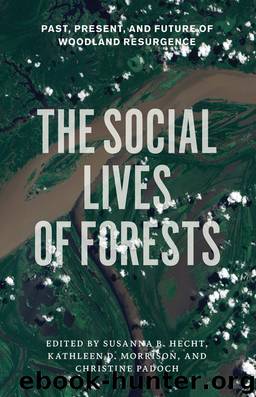The Social Lives of Forests: Past, Present, and Future of Woodland Resurgence by edited by Susanna B. Hecht Kathleen D. Morrison & Christine Padoch

Author:edited by Susanna B. Hecht, Kathleen D. Morrison & Christine Padoch [Hecht, Susanna B.]
Language: eng
Format: epub
Publisher: The University of Chicago Press
Narratives of Change: Northern Laos
Across the border in Northern Laos a different story has unfolded.4 Postwar political insecurity until the mid-1980s prevented active development efforts in the uplands; government agents, however, encouraged upland people to move to lower elevations and to consolidate their villages into larger centers that could be assisted by government service providers. In the early 1990s, the Lao government introduced measures to demarcate forests and protected areas (National Biodiversity Conservation Areas Law of 1993 and Forest Law of 1996). The National Land and Forest Allocation Policy (LFA), proclaimed national policy in 1996, supported the delineation of village boundaries, and recognized village’s rights to manage and use forest resources as well as farmers’ rights to use agricultural land (Fujita and Phanvilay 2008). The LFA categorized forest areas and agricultural lands at the village level, and in the process, sought to stop shifting cultivation in upland areas.
In the mid-1980s, the Lao government began to liberalize the market and to promote private sector activity. This was followed by the removal of agricultural price regulations, production quotas, and agricultural taxes, actions that allowed farmers to sell their products freely without government intervention. In the mid-1990s the goal of the government’s agricultural policy switched from one of improving food production to an emphasis on integrating rural farmers into the market economy.
In the early 1990s the government opened international borders with neighboring countries and began constructing improved roads. These changes launched new economic opportunities, particularly for farmers living near roads. These changes also released an influx of people and goods. Chinese investors initiated new projects including investments with relatives who live across the border as well as small-scale private investment that encouraged farmers to transition from subsistence to cash-crop production. A Chinese national government program provided Chinese investors with government funds for projects that sought to eradicate opium in Laos and Burma. Under the guise of opium eradication, these investors supplied Lao farmers with planting materials for cash crops ranging from rice, watermelons, chilies, and pumpkins in the lowlands, to maize, sugarcane, and rubber in the uplands. The combination of investment capital and market opportunities encouraged Lao farmers to plant these crops in their dry season paddies and upland agricultural fields (including both active swiddens and forest fallows). These incentives also created agricultural wage labor opportunities in areas where cash crop production became prominent. These new economic opportunities motivated upland households to move to lower elevations near roads to access both agricultural land and wage labor opportunities.
In 2002 the national government initiated a national campaign to eradicate opium cultivation in upland areas by 2005. Villages found cultivating opium were fined and their leaders detained in district centers for “reeducation.” These activities triggered another exodus of upland people to lower elevations, where they often settled near relatives or earlier settlers. Fujita et al. (2007) documented a 20 percent decline in the number of Akha villages in Sing District between 1995 and 2005, as villages were relocated at lower elevations and consolidated. They also showed
Download
This site does not store any files on its server. We only index and link to content provided by other sites. Please contact the content providers to delete copyright contents if any and email us, we'll remove relevant links or contents immediately.
| Anatomy | Animals |
| Bacteriology | Biochemistry |
| Bioelectricity | Bioinformatics |
| Biology | Biophysics |
| Biotechnology | Botany |
| Ecology | Genetics |
| Paleontology | Plants |
| Taxonomic Classification | Zoology |
Sapiens: A Brief History of Humankind by Yuval Noah Harari(14258)
The Tidewater Tales by John Barth(12609)
Mastermind: How to Think Like Sherlock Holmes by Maria Konnikova(7233)
Do No Harm Stories of Life, Death and Brain Surgery by Henry Marsh(6891)
The Thirst by Nesbo Jo(6832)
Why We Sleep: Unlocking the Power of Sleep and Dreams by Matthew Walker(6620)
Life 3.0: Being Human in the Age of Artificial Intelligence by Tegmark Max(5479)
Sapiens by Yuval Noah Harari(5297)
The Longevity Diet by Valter Longo(5021)
The Body: A Guide for Occupants by Bill Bryson(4978)
The Rules Do Not Apply by Ariel Levy(4868)
The Immortal Life of Henrietta Lacks by Rebecca Skloot(4528)
Animal Frequency by Melissa Alvarez(4399)
Why We Sleep by Matthew Walker(4364)
The Hacking of the American Mind by Robert H. Lustig(4319)
Yoga Anatomy by Kaminoff Leslie(4310)
All Creatures Great and Small by James Herriot(4236)
Double Down (Diary of a Wimpy Kid Book 11) by Jeff Kinney(4209)
Embedded Programming with Modern C++ Cookbook by Igor Viarheichyk(4110)
